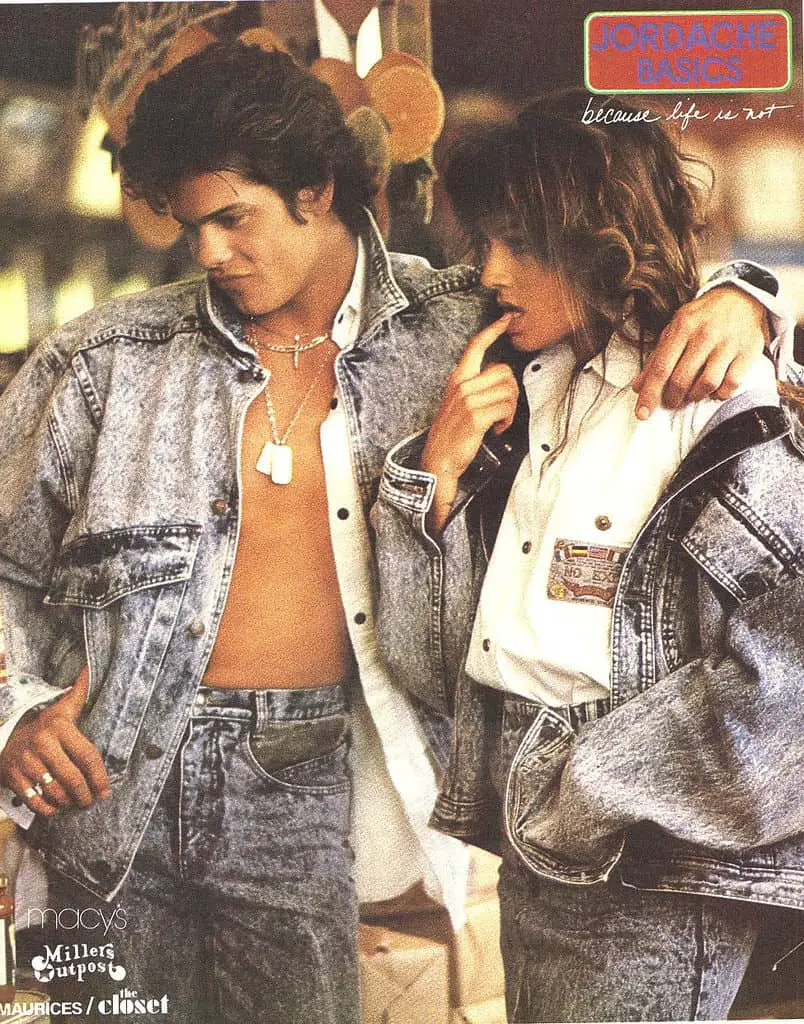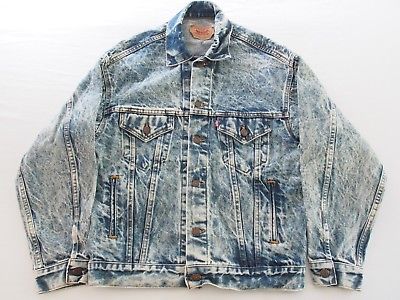
There are a few clothing items and accessories that stick out as one of the definitive styles of the 1980s.
Acid wash jeans were a clothing style that originated in the early
So read on or listen to the podcast version!
I remember the first pair of acid wash jeans I got. I was flipping out. I think they were from the local Zellars but I didn’t give a crap I finally got to wear what I thought was the coolest style of the time.
You may have thought that too and had your own acid wash memories. For me, the pinnacle of acid wash was the jean jacket I got. I loved the one that Marty McFly wore in the original Back to the Future so this, to me, was the pinnacle of fashion.
Turns out acid wash jeans, and everything to do with acid wash, goes back way further than the ‘80s. The style is based in stone washing and the original modern production of them was discovered by accident. Spoiler alert: there isn’t even any acid…
Setting The Stage For Acid Wash Jeans
Our story actually starts with stone washing which set the stage for acid washing. There are various versions of who actually invented this style of washing. As early as 1950 Levi’s said that a guy named Donald Freeland first invented stone washing while working for the Great Western Garment Company.
Levi’s would eventually take over GWGC and with that, they took on the story of the creation of stone washing.
But at the same time, the idea was seen to have not been invented until the 1970s by a guy named Claude Blankiet who said the idea was his. Then the jeans company Edwin said that they invented this technique in 1980. Seems a little late to the party if you ask me.
According to actual fashion related people, Marithe and Francois Girbaud are credited as being the inventors of the modern industrialization of the stone-washing technique.
I had no idea there was such beef over a technique.
What Is Stone Washing?
Stone washing is important because it sets the stage for how acid wash jeans, and garments, would be developed. The idea of stone washing is that it gives a newly manufactured garment a more worn-in appearance. In the case of denim, it’s great because it helps to soften up the fabric which starts out as really rigid and stiff.
The whole process actually uses large stones to roughen up whatever fabric is being processed. The garments are placed in a large horizontal industrial clothes washer that has a bunch of stones dumped in it the same way a toddler might to the family washing machine.
As the wash cycle rotates the clothes fibers have the ever living hell pounded out of them as the tumbling stones ride up the paddles inside the drum and fall back down onto the fabric. Call this a torture device for a pair of Levi’s.
The Great Pumice Shortage
Pumice stone was the most popular for stone washing to help give the jeans that faded and worn look. The problem was that stone washing had become so popular that it was hurting the pumice supply.
Most pumice was important from places like Italy, Greece, and Turkey and it was becoming more and more expensive. In the States they look inward to see if there were any vast pumice deposits they could harvest like oil and they found some in Arizona, California, and New Mexico.
So mining companies started pillaging the pumice supplies of these states leading to outcries from ecologists groups. They were causing havoc trying to dig up all this pumice and then there was the issue with the leftover pumice from the stone washing process. The pumice was now chemically tainted and became residue that had to be disposed of.
Everyone was told to start taking it easy with the pumice.
Finding A New Way To Stone Wash
I bet you never knew what drama there was in the pumice and garment industry? Forced to find a new solution, Claude Blankeit (mentioned above) promoted the use of cullulase enzymes in the finishing industry. Cellulase had been used in things like paper pulp and food processing and was made from fungi and bacterias. This enzyme could decompress fibers and this was able to create that similar look that was happening with the stone washing. This would reduce, if not eliminate, the dwindling pumice supply or the southwest.
So Blankiet might not have been at the forefront of the actual stone washing creation but he helped to keep control of the manufacturing process. This makes me a big Blankiet guy now…
The Early Days Of Acid Wash
The look of acid wash has been part of popular culture since the 1960s and you just have to look at all those dirty hippies who were surfing and not going to work. Old school Levi’s jeans were a staple item of the 1950s and people would continue wearing them into the ‘60s.
Surfers and members of the counterculture prized the classic Levi 501’s. By this time they had been wearing them for years and the appearance of the 501’s was starting to change. They were being bleached by salt water and this was giving them a much more authentic “lived-in” appearance.
This natural wear process was taking months, if not years to happen but people were really starting to dig the look. People would start trying to produce these at home by buying new pairs of Levi’s, hanging them and leaving them to fade in the sun. This would take some work because they would have to be turned over and rotated in order to give them that full “lived-in” look.
If you were a dirty lazy surfer this was just too much work, not that they really knew what work was anyway but they wanted a faster way to get the desired appearance. They would speed up the process by soaking the jeans in some diluted bleach and beach sand. You’ve got to hand it to those dirty suffers, it wasn’t a bad idea.
It was easy to get simple chlorine bleach and muriatic acid at that time as they were used by most swimming pools which they probably stole it from.
The Acid Wash Jeans Of The 1980s

Despite them being dirty surfers the look of the jeans they wore stuck with people and would be embraced in the early ‘80s by another dirty group:
Punk rockers.
In the early ‘80s punk rockers and skinheads would splatter bleach on their jeans and jackets for a kind of mottled effect but one that looked similar to camouflage. Sort of. This faded look would come to be known as “snow wash” and would still keep the dark denim look around the waistband and seams.
As it always seems to be, anything that’s done by underground or punk culture tends to get picked up by massive corporations to sell and exploit. This new “snow wash” look was no exception. Instead of calling them snow washed the newly manufactured
The pre-washed jeans made by Guess were showing up on models and in advertisements. The association with the punk movement was starting to fade away and “acid wash” jeans were starting to become a style. Many of those that would first embrace them would have no idea they came out of the punk rock scene.
People started trying to replicate their own acid wash jeans in order not to pay the huge amount being charged by companies like Guess. People were trying to recreate the look by dipping their old jeans in diluted bleach and then trying to embellish them with things like metal studs, embroidery, and rhinestones.
Everywhere You Look
By now acid wash jeans and jackets are everywhere. They were more accessible because they were something that you could make at home. I remember girls in school becoming good at creating their own that honestly didn’t look too different than brand name ones.
By 1986 acid wash jeans were a full-on industry, everyone was producing some version of them but the modern process of acid washing
This new process was then industrialized in by American Garment Finishers of Texas in June of 1986 and they offered it to Levi’s. AGF would further refine the process by ditching the bleach (sorry skinheads) and using Potassium Permanganate. This would give the jeans more of a natural worn away look and was much less damaging to the cotton fibers.
If you were worried about the pumice, fear not as they limited their use of it and used other ways to create the worn away look by using marble sand and expanded glass foam. This would help preserve the poor sweet pumice.
The Sad Decline Of Acid Wash Jeans

So acid wash jeans are going along great. The jackets and jean combination looks amazing and if you paired them with high top white sneakers you were basically Zack Morris.
But like any fad, it started to fade out. That’s kind of a funny joke thinking about faded denim but if you didn’t laugh I’m ok with it. The problem is people were starting to go too extreme with the faded acid wash effect. Glam metal bands were going with jeans that had been bleached so bad they were basically white.
Snow washed jeans, which retained a lot of the dark blue denim were still in the mix and would get embraced by the grunge movement that was coming in the ‘90s.
As for acid wash, it’s time in the sun had come to an end. That’s also funny when you think about the original surfers trying to bleach their jeans in the sun. Or maybe it’s not…
Acid wash jeans made a bit of a comeback in the late 2000s as there was a bit of an ‘80s revival underway and it’s still hung on for a little bit. Whether or not it ever makes a full-on comeback is up in the air but we’ll all remember that glorious time when we were covered in denim from head to foot.



